State-of-the-Art and Opportunities for Bioactive Pentacyclic Triterpenes from Native Mexican Plants
Abstract
:1. Introduction
1.1. General Overview of Pentacyclic Triterpenes
1.1.1. Structure, Classification, Distribution, and Biological Importance
1.1.2. Biosynthesis
2. Pentacyclic Triterpenes from Mexican Plants
2.1. Biological Activity Survey of PCTs Found in Mexican Plants
2.2. Extraction and Purification Methods
2.3. Drug Delivery Strategies
3. Opportunities, Limitations, and Future of Pentacyclic Triterpene Research in Mexico
4. Conclusions
Supplementary Materials
Author Contributions
Funding
Institutional Review Board Statement
Informed Consent Statement
Data Availability Statement
Acknowledgments
Conflicts of Interest
References
- Comisión Nacional para el Conocimiento y Uso de la Biodiversidad (CONABIO). Biodiversidad Mexicana. Available online: https://www.biodiversidad.gob.mx/pais/quees (accessed on 15 April 2022).
- Mittermeier, R.A.; Turner, W.R.; Larsen, F.W.; Brooks, T.M.; Gascon, C. Global biodiversity conservation: The critical role of hotspots. In Biodiversity Hotspots: Distribution and Protection of Conservation Priority Areas; Zachos, F.E., Habel, J.C., Eds.; Springer: Berlin/Heidelberg, Germany, 2011; pp. 3–22. [Google Scholar]
- Llorente-Bousquets, J.; Ocegueda, S. Estado del conocimiento de la biota In Capital Natural de México, Volume I: Conocimiento Actual de la Biodiversidad; CONABIO: México City, México, 2008; pp. 283–322. [Google Scholar]
- Laszczyk, M. Pentacyclic Triterpenes of the Lupane, Oleanane and Ursane Group as Tools in Cancer Therapy. Planta Med. 2009, 75, 1549–1560. [Google Scholar] [CrossRef] [PubMed] [Green Version]
- Malinowska, M.; Sikora, E.; Ogonowski, J. Production of triterpenoids with cell and tissue cultures. Acta Biochim. Pol. 2013, 60, 731–735. [Google Scholar] [CrossRef] [Green Version]
- Menaa, F.; Badole, S.; Menaa, B.; Menaa, A.; Bodhankar, S. Anti-Inflammatory Benefits of Pentacyclic Triterpenes. In Bioactive Food as Dietary Interventions for Arthritis and Related Inflammatory Diseases; Ross Watson, R., Preedy, V.R., Eds.; Academic Press: San Diego, CA, USA, 2012; pp. 413–419. [Google Scholar]
- Sharma, H.; Kumar, P.; Deshmukh, R.R.; Bishayee, A.; Kumar, S. Pentacyclic triterpenes: New tools to fight metabolic syndrome. Phytomedicine 2018, 50, 166–177. [Google Scholar] [CrossRef]
- Dev, S. General Introduction. In Handbook of Terpenoids. Volume I: Triterpenoids, Acyclic, Monocyclic, Bicyclic, Tricyclic and Tetracyclic Terpenoids; Dev, S., Ed.; CRC Press: Boca Raton, FL, USA, 2018; p. 72. [Google Scholar]
- Leyva-López, N.; Gutiérrez-Grijalva, E.P.; Vazquez Olivo, G.; Contreras Angulo, L.A.; Emus Medina, A.; Basilio Heredia, J. Terpenes in oregano: Constituents, extraction, analysis and biological properties. In Terpenes: Biosynthesis, Applications and Research; Bjarke, A., Ed.; Nova Science Publishers: Hauppauge, NY, USA, 2018; pp. 1–63. [Google Scholar]
- Razdan, S. An update towards the production of plant secondary metabolites. In Recent Trends and Techniques in Plant Metabolic Engineering; Yadav, S.K., Kumar, V., Singh, S.P., Eds.; Springer: Singapore, 2018; pp. 1–17. [Google Scholar]
- Hanson, J.R. The Pentacyclic Triterpenes. In Pentacyclic Triterpenes as Promising Agents in Cancer; Salvador, J.A.R., Ed.; Nova Science Publishers: New York, NY, USA, 2010; pp. 1–11. [Google Scholar]
- Ghosh, S.U.M.I.T. Biosynthesis of structurally diverse triterpenes in plants: The role of oxidosqualene cyclases. Proc. Indian Natl. Sci. Acad. 2016, 82, 1189–1210. [Google Scholar] [CrossRef]
- Jäger, S.; Trojan, H.; Kopp, T.; Laszczyk, M.N.; Scheffler, A. Pentacyclic triterpene distribution in various plants–rich sources for a new group of multi-potent plant extracts. Molecules 2009, 14, 2016–2031. [Google Scholar] [CrossRef] [Green Version]
- Patocka, J. Biologically active pentacyclic triterpenes and their current medicine signification. J. Appl. Biomed. 2003, 1, 7–12. [Google Scholar] [CrossRef] [Green Version]
- Parmar, S.K.; Sharma, T.P.; Airao, V.B.; Bhatt, R.; Aghara, R.; Chavda, S.; Rabadiya, S.O.; Gangwal, A.P. Neuropharmacological effects of triterpenoids. Phytopharmacology 2013, 4, 354–372. [Google Scholar]
- Harun, N.H.; Septama, A.W.; Ahmad, W.A.N.W.; Suppian, R. Immunomodulatory effects and structure-activity relationship of botanical pentacyclic triterpenes: A review. Chin. Herb. Med. 2020, 12, 118–124. [Google Scholar] [CrossRef]
- Rufino-Palomares, E.E.; Perez-Jimenez, A.; Reyes-Zurita, F.J.; Garcia-Salguero, L.; Mokhtari, K.; Herrera-Merchán, A.; Medina, P.P.; Peragón, J.; Lupianez, J.A. Anti-cancer and anti-angiogenic properties of various natural pentacyclic tri-terpenoids and some of their chemical derivatives. Curr. Org. Chem. 2015, 19, 919–947. [Google Scholar] [CrossRef]
- Yang, H.; Kim, H.; Kim, Y.; Sung, S. Cytotoxic activities of naturally occurring oleanane-, ursane-, and lupane-type triterpenes on HepG2 and AGS cells. Pharmacogn. Mag. 2017, 13, 118–122. [Google Scholar] [CrossRef] [Green Version]
- Ludwiczuk, A.; Skalicka-Woźniak, K.; Georgiev, M.I. Terpenoids. In Pharmacognosy; Badal, S., Delgoda, R., Eds.; Academic Press: Amsterdam, The Netherlands, 2017; pp. 233–266. [Google Scholar]
- Gleason, F.; Chollet, R. Plant Biochemistry; Jones & Bartlett Learning: Sudbury, MA, USA, 2012; pp. 100–118. [Google Scholar]
- Cheng, A.X.; Lou, Y.G.; Mao, Y.B.; Lu, S.; Wang, L.J.; Chen, X.Y. Plant Terpenoids: Biosynthesis and Ecological Functions. J. Integr. Plant Biol. 2007, 49, 179–186. [Google Scholar] [CrossRef]
- Buchanan, B.B.; Gruissem, W.; Jones, R.L. (Eds.) Biochemistry and Molecular Biology of Plants; John Wiley & Sons: Hoboken, NJ, USA, 2015; pp. 1138–1141. [Google Scholar]
- Thimmappa, R.; Geisler, K.; Louveau, T.; O’Maille, P.; Osbourn, A. Triterpene biosynthesis in plants. Annu. Rev. Plant Biol. 2014, 65, 225–257. [Google Scholar] [CrossRef] [PubMed]
- Forestier, E.; Romero-Segura, C.; Pateraki, I.; Centeno, E.; Compagnon, V.; Preiss, M.; Berna, A.; Boronat, A.; Bach, T.J.; Darnet, S.; et al. Distinct triterpene synthases in the laticifers of Euphorbia lathyris. Sci. Rep. 2019, 9, 4840. [Google Scholar]
- Stephenson, M.J.; Field, R.A.; Osbourn, A. The protosteryl and dammarenyl cation dichotomy in polycyclic triterpene biosynthesis revisited: Has this ‘rule’finally been broken? Nat. Prod. Rep. 2019, 36, 1044–1052. [Google Scholar] [CrossRef] [PubMed] [Green Version]
- Hu, D.; Gao, H.; Yao, X.S. Biosynthesis of Triterpenoid Natural Products. In Comprehensive Natural Products III. Chemistry and Biology; Townsend, C.A., Abe, I., Tang, Y., Liu, H.-W., Begley, T.-P., Eds.; Elsevier: Amsterdam, The Netherlands, 2020; Volume 1, pp. 1–33. [Google Scholar]
- Gutiérrez, G.; Valencia, L.M.; Giraldo-Dávila, D.; Combariza, M.Y.; Galeano, E.; Balcazar, N.; Panay, A.J.; Jerez, A.M.; Montoya, G. Pentacyclic Triterpene Profile and Its Biosynthetic Pathway in Cecropia telenitida as a Prospective Dietary Supplement. Molecules 2021, 26, 1064. [Google Scholar] [CrossRef]
- Ghosh, S. Triterpene structural diversification by plant cytochrome P450 enzymes. Front. Plant Sci. 2017, 8, 1886. [Google Scholar] [CrossRef]
- Jiménez-Arellanes, A.; Meckes, M.; Torres, J.; Luna-Herrera, J. Antimycobacterial triterpenoids from Lantana hispida (Verbenaceae). J. Ethnopharmacol. 2007, 111, 202–205. [Google Scholar] [CrossRef]
- Mena-Rejón, G.J.; Pérez-Espadas, A.R.; Moo-Puc, R.E.; Cedillo-Rivera, R.; Bazzocchi, I.L.; Jiménez-Diaz, I.A.; Quijano, L. Antigiardial activity of triterpenoids from root bark of Hippocratea excelsa. J. Nat. Prod. 2007, 70, 863–865. [Google Scholar] [CrossRef]
- Manríquez-Torres, J.J.; Zúñiga-Estrada, A.; González-Ledesma, M.; Torres-Valencia, J.M. The antibacterial metabolites and proacacipetalin from Acacia cochliacantha. J. Mex. Chem. Soc. 2007, 51, 228–231. [Google Scholar]
- Cáceres-Castillo, D.; Mena-Rejón, G.J.; Cedillo-Rivera, R.; Quijano, L. 21β-Hydroxy-oleanane-type triterpenes from Hippocratea excelsa. Phytochemistry 2008, 69, 1057–1064. [Google Scholar] [CrossRef]
- Jiménez-Arellanes, A.; Luna-Herrera, J.; Cornejo-Garrido, J.; López-García, S.; Castro-Mussot, M.E.; Meckes-Fischer, M.; Mata-Espinosa, D.; Marquina, B.; Torres, J.; Hernández-Pando, R. Ursolic and oleanolic acids as antimicrobial and immunomodulatory compounds for tuberculosis treatment. BMC Complement. Altern. Med. 2013, 13, 258. [Google Scholar] [CrossRef] [PubMed] [Green Version]
- Egas, V.; Salazar-Cervantes, G.; Romero, I.; Méndez-Cuesta, C.A.; Rodríguez-Chávez, J.L.; Delgado, G. Anti-Helicobacter pylori metabolites from Heterotheca inuloides (Mexican arnica). Fitoterapia 2018, 127, 314–321. [Google Scholar] [CrossRef] [PubMed]
- Delgado-Altamirano, R.; López-Palma, R.I.; Monzote, L.; Delgado-Domínguez, J.; Becker, I.; Rivero-Cruz, J.F.; Esturau-Escofet, N.; Vázquez-Landaverde, P.A.; Rojas-Molina, A. Chemical constituents with leishmanicidal activity from a pink-yellow cultivar of Lantana camara var. Aculeata (L.) collected in Central Mexico. Int. J. Mol. Sci. 2019, 20, 872. [Google Scholar] [CrossRef] [PubMed] [Green Version]
- Nocedo-Mena, D.; Rivas-Galindo, V.M.; Navarro, P.; Garza-González, E.; González-Maya, L.; Ríos, M.Y.; García, A.; Ávalos-Alanís, F.J.; Rodríguez-Rodríguez, J.; Camacho-Corona, M.R. Antibacterial and cytotoxic activities of new sphingolipids and other constituents isolated from Cissus incisa leaves. Heliyon 2020, 6, e04671. [Google Scholar] [CrossRef] [PubMed]
- López-Huerta, F.A.; Nieto-Camacho, A.; Morales-Flores, F.; Hernández-Ortega, S.; Chávez, M.I.; Cuesta, C.A.M.; Martínez, I.; Espinoza, B.; Espinosa-García, F.J.; Delgado, G. Hopane-type triterpenes from Cnidoscolus spinosus and their bioactivities. Bioorg. Chem. 2020, 100, 103919. [Google Scholar] [CrossRef]
- Perez, G.R.M.; Vargas, S.R. Triterpenes from Agarista mexicana as potential antidiabetic agents. Phytother. Res. 2002, 16, 55–58. [Google Scholar] [CrossRef]
- Romero-Estrada, A.; Maldonado-Magaña, A.; González-Christen, J.; Bahena, S.M.; Garduño-Ramírez, M.L.; Rodríguez-López, V.; Alvarez, L. Anti-inflammatory and antioxidative effects of six pentacyclic triterpenes isolated from the Mexican copal resin of Bursera copallifera. BMC Complement. Altern. Med. 2016, 16, 422. [Google Scholar] [CrossRef] [Green Version]
- Figueroa-Suárez, M.Z.; Christen, J.G.; Cardoso-Taketa, A.T.; Villafuerte, M.D.C.G.; Rodríguez-López, V. Anti-inflammatory and antihistaminic activity of triterpenoids isolated from Bursera cuneata (Schldl.) Engl. J. Ethnopharmacol. 2019, 238, 111786. [Google Scholar] [CrossRef]
- Novillo, F.; Velasco-Barrios, E.; Nieto-Camacho, A.; López-Huerta, F.A.; Cuesta, C.A.M.; Ramírez-Apan, M.T.; Chávez, M.I.; Martínez, E.M.; Hernández-Delgado, T.; Espinosa-García, F.J.; et al. 3β-Palmitoyloxy-olean-12-ene analogs from Sapium lateriflorum (Euphorbiaceae): Their cytotoxic and anti-inflammatory properties and docking studies. Fitoterapia 2021, 155, 105067. [Google Scholar] [CrossRef]
- Rios, M.Y.; López-Martínez, S.; López-Vallejo, F.; Medina-Franco, J.L.; Villalobos-Molina, R.; Ibarra-Barajas, M.; Navarrete-Vázquez, G.; Hidalgo-Figueroa, S.; Hernández-Abreu, O.; Estrada-Soto, S. Vasorelaxant activity of some structurally related triterpenic acids from Phoradendron reichenbachianum (Viscaceae) mainly by NO production: Ex vivo and in silico studies. Fitoterapia 2012, 83, 1023–1029. [Google Scholar] [CrossRef]
- Luna-Vázquez, F.J.; Ibarra-Alvarado, C.; Camacho-Corona, M.D.R.; Rojas-Molina, A.; Rojas-Molina, J.I.; García, A.; Bah, M. Vasodilator activity of compounds isolated from plants used in Mexican traditional medicine. Molecules 2018, 23, 1474. [Google Scholar] [CrossRef] [PubMed] [Green Version]
- Macías-Rubalcava, M.L.; Hernández-Bautista, B.E.; Jiménez-Estrada, M.; Cruz-Ortega, R.; Anaya, A.L. Pentacyclic triterpenes with selective bioactivity from Sebastiania adenophora leaves, Euphorbiaceae. J. Chem. Ecol. 2007, 33, 147–156. [Google Scholar] [CrossRef] [PubMed]
- Rios, M.Y.; Ortega, A.; Domínguez, B.; Déciga, M.; De la Rosa, V. Glaucacetalin E and galphimidin B from Galphimia glauca and their anxiolytic activity. J. Ethnopharmacol. 2020, 259, 112939. [Google Scholar] [CrossRef]
- Vardanyan, R.S.; Hurby, V.J. Insulin and Synthetic Hypoglycemic Agents. In Synthesis of Essential Drugs; Vardanyan, R.S., Hurby, V.J., Eds.; Elsevier: Amsterdam, The Netherlands, 2006; pp. 343–348. [Google Scholar]
- Gutiérrez-Rebolledo, G.A.; Garduño-Siciliano, L.; García-Rodríguez, R.V.; Pérez-González, M.Z.; Chávez, M.I.; Bah, M.; Siordia-Reyes, G.A.; Chamorro-Cevallos, G.A.; Jiménez-Arellanes, M.A. Anti-inflammatory and toxicological evaluation of Moussonia deppeana (Schldl. & Cham) Hanst and Verbascoside as a main active metabolite. J. Ethnopharmacol. 2016, 187, 269–280. [Google Scholar] [PubMed]
- Sánchez-Monroy, M.B.; León-Rivera, I.; Llanos-Romero, R.E.; García-Bores, A.M.; Guevara-Fefer, P. Cytotoxic activity and triterpenes content of nine Mexican species of Bursera. Nat. Prod. Res. 2021, 35, 4881–4885. [Google Scholar] [CrossRef]
- Khaled, M.; Jiang, Z.Z.; Zhang, L.Y. Deoxypodophyllotoxin: A promising therapeutic agent from herbal medicine. J. Ethnopharmacol. 2013, 149, 24–34. [Google Scholar] [CrossRef]
- Torres-Ortiz, D.A.; Rodríguez deLeón, E.; Mousthapa, B.; Ibarra-Alvarado, C.; Mercado-Silva, E.; Castro-Ruiz, J.E.; Rivera-Pastrana, D.M. Vasorelaxing effect and possible chemical markers of the flowers of the Mexican Crataegus gracilior. Nat. Prod. Res. 2019, 34, 2522–3525. [Google Scholar] [CrossRef]
- Wohlfarth, C. Permitivity (dielectric constant) of liquids. In CRC Handbook of Chemistry and Physics, 88th ed.; Lide, D.R., Baysinger, G., Berger, L.I., Goldberg, R.N., Kehiaian, H.V., Kuchitsu, K., Rosenblatt, G., Roth, D.L., Zwillinger, D., Eds.; CRC Press: Boca Raton, FL, USA, 2008; pp. 148–169. [Google Scholar]
- Nema, S.; Ludwig, J.D. (Eds.) Pharmaceutical Dosage Forms: Parenteral Medications, 3 Volume 1 Formulation and Packaging; Informa Healthcare: New York, NY, USA, 2010; p. 303. [Google Scholar]
- Valdés, K.; Morales, J.; Rodríguez, L.; Günther, G. Potential use of nanocarriers with pentacyclic triterpenes in cancer treatments. Nanomedicine 2016, 12, 3139–3156. [Google Scholar] [CrossRef]
- Alvarado, H.L.; Abrego, G.; Souto, E.B.; Garduno-Ramirez, M.L.; Clares, B.; García, M.L.; Calpena, A.C. Nanoemulsions for dermal controlled release of oleanolic and ursolic acids: In vitro, ex vivo and in vivo characterization. Colloids Surf. B Biointerfaces 2015, 130, 40–47. [Google Scholar] [CrossRef]
- Alvarado, H.L.; Abrego, G.; Garduño-Ramirez, M.L.; Clares, B.; Calpena, A.C.; García, M.L. Design and optimization of oleanolic/ursolic acid-loaded nanoplatforms for ocular anti-inflammatory applications. Nanomed. Nanotechnol. Biol. Med. 2015, 11, 521–530. [Google Scholar] [CrossRef]
- Calderón-Chiu, C.; Calderón-Santoyo, M.; Damasceno-Gomes, S.; Ragazzo-Sánchez, J.A. Use of jackfruit leaf (Artocarpus heterophyllus L.) protein hydrolysates as a stabilizer of the nanoemulsions loaded with extract-rich in pentacyclic triterpenes obtained from Coccoloba uvifera L. leaf. Food Chem. X 2021, 12, 100138. [Google Scholar] [CrossRef] [PubMed]
- González-Block, M.A.; Reyes Morales, H.; Cahuana Hurtado, L.; Balandrán, A.; Méndez, E. Mexico health system review. In Heatlh Systems in Transition; Allin, S., Marchildon, G., Eds.; World Health Organization: North American Observatory on Health Systems and Policies and European Observatory on Health Systems and Policies: Copenhagen, Denmark, 2020; Volume 22, pp. 1–221. [Google Scholar]
- Xu, C.; Wang, B.; Pu, Y.; Tao, J.; Zhang, T. Techniques for the analysis of pentacyclic triterpenoids in medicinal plants. J. Sep. Sci. 2018, 41, 6–19. [Google Scholar] [CrossRef] [PubMed] [Green Version]
- Picot-Allain, C.; Mahomoodally, M.F.; Ak, G.; Zengin, G. Conventional versus green extraction techniques—A comparative perspective. Curr. Opin. Food Sci. 2021, 40, 144–156. [Google Scholar] [CrossRef]
- Mejía-Manzano, L.A.; Barba-Dávila, B.A.; Vázquez-Villegas, P.; Serna-Saldívar, S.O.; González-Valdez, J. Improved extraction of the natural anticancerigen pristimerin from Mortonia greggii root bark using green solvents and aqueous two-phase systems. Sep. Pur. Technol. 2019, 211, 667–672. [Google Scholar] [CrossRef]
- González-Félix, M.A.; Mejía-Manzano, L.A.; Barba-Dávila, B.A.; Serna-Saldívar, S.O.; González-Valdez, J. Optimized and scalable green extraction of pristimerin, an anticancerigen from Mortonia greggii, by ethanol–phosphate aqueous two-phase systems. Ind. Eng. Chem. Res. 2021, 60, 5403–5410. [Google Scholar] [CrossRef]
- SciVal. Elsevier. Available online: https://0-www-scival-com.biblioteca-ils.tec.mx/reports (accessed on 11 August 2022).
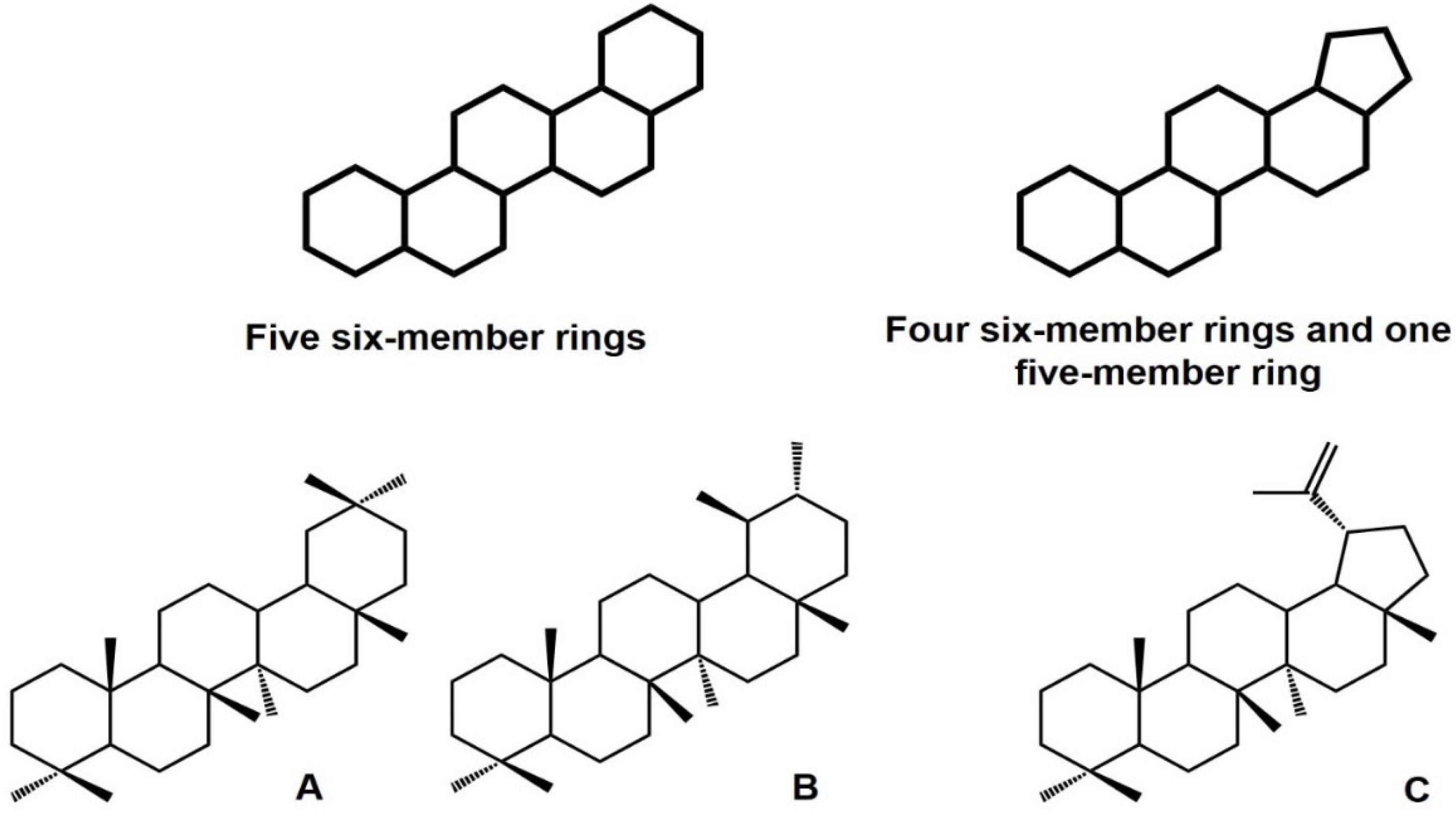
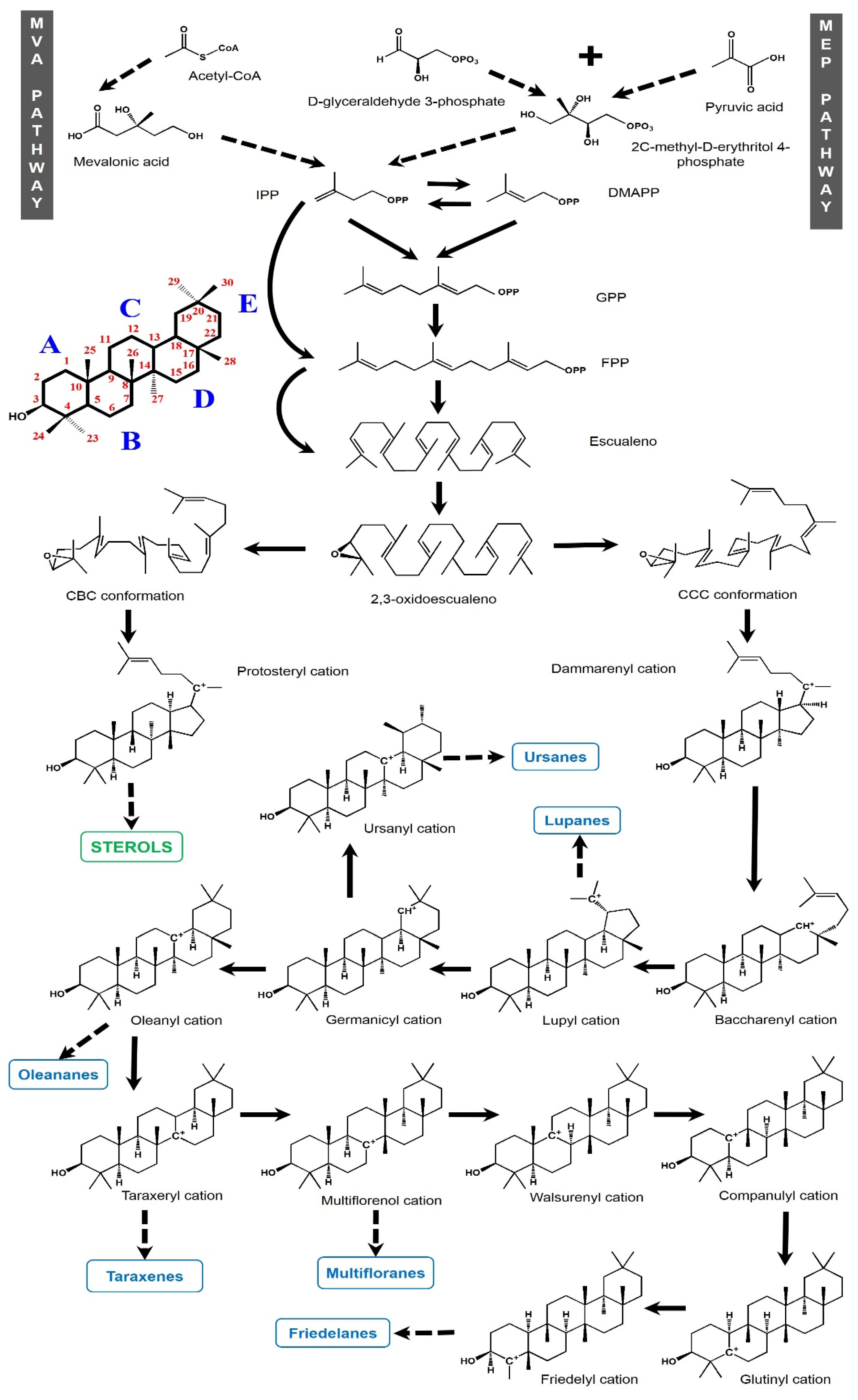
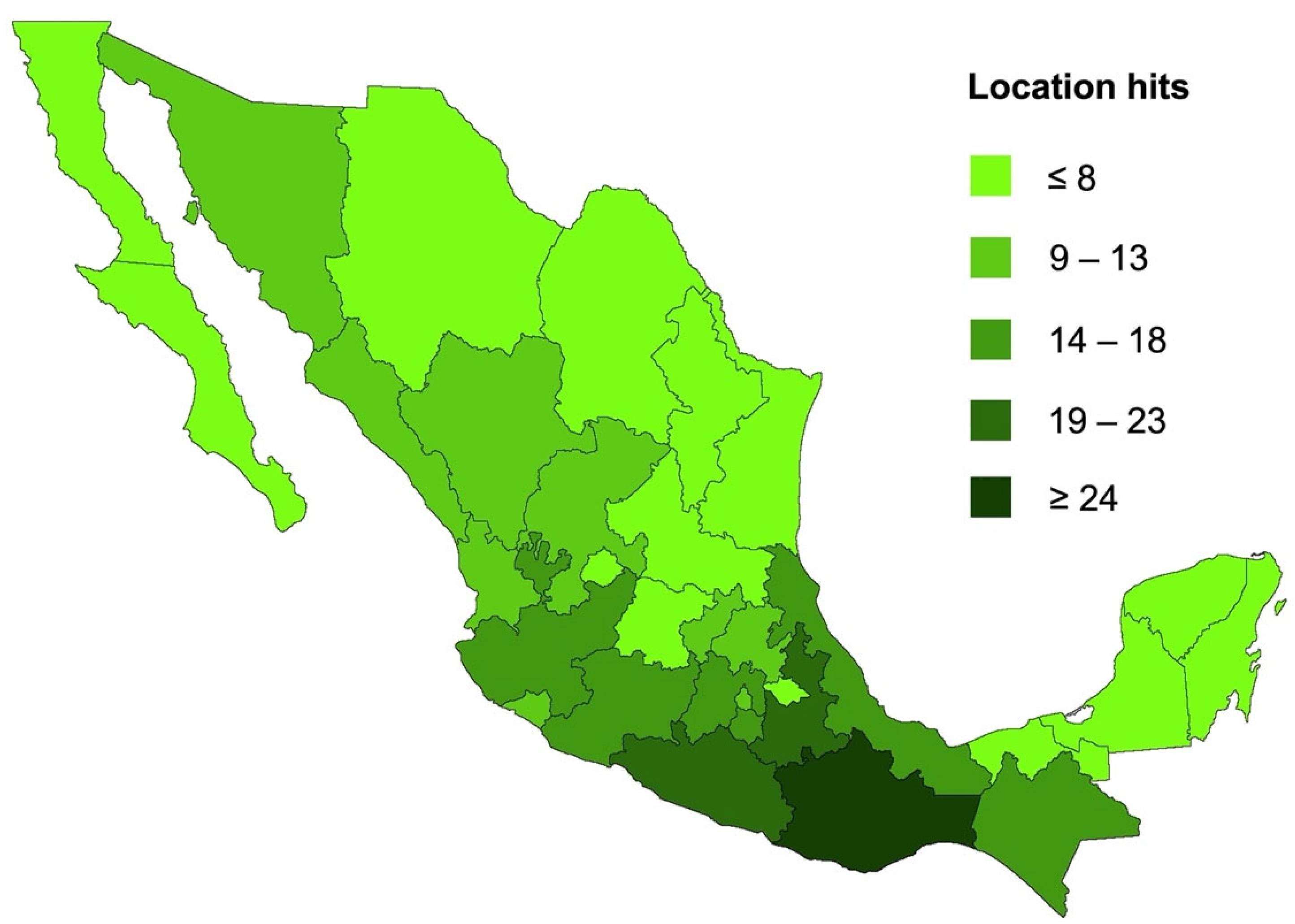
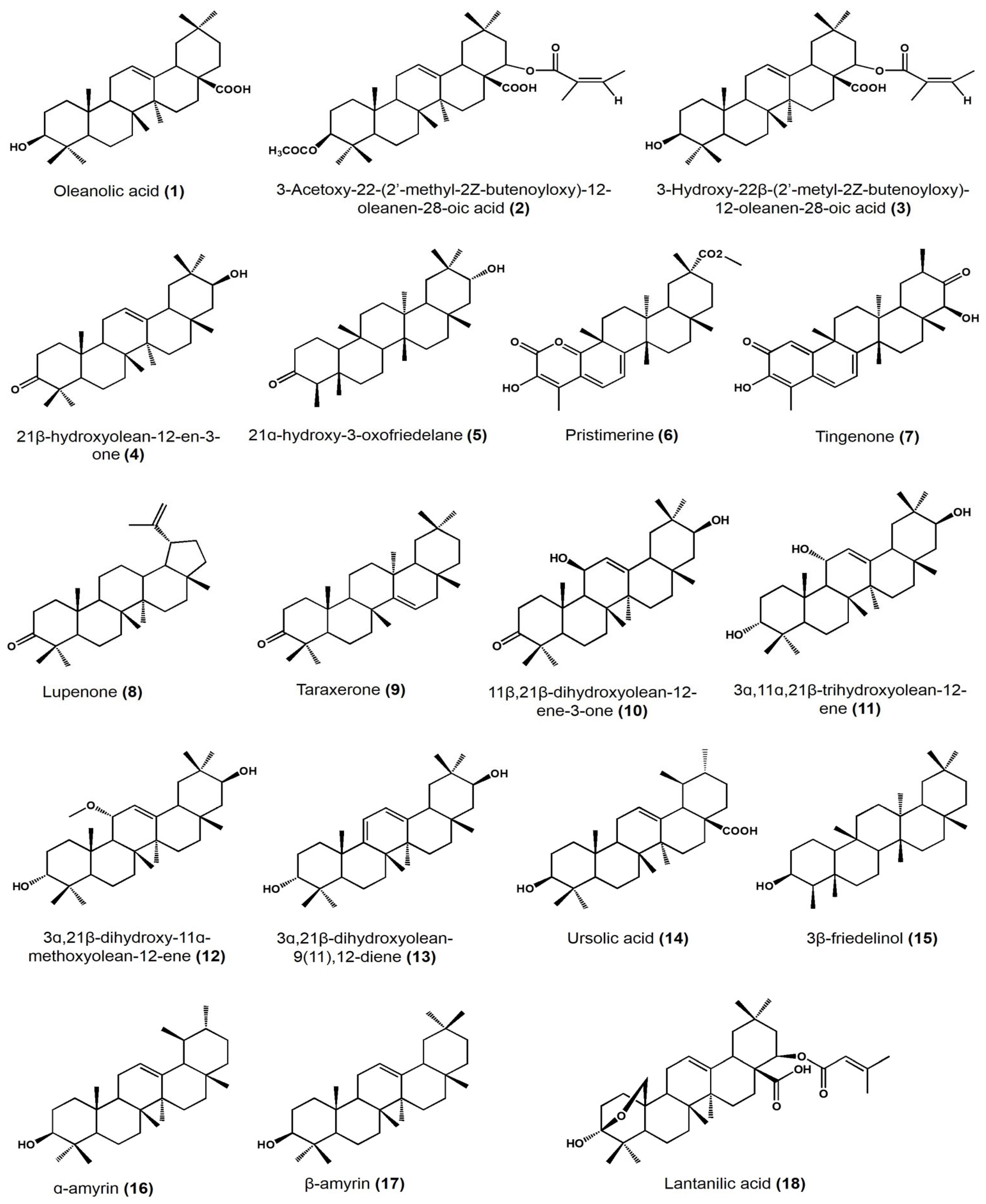

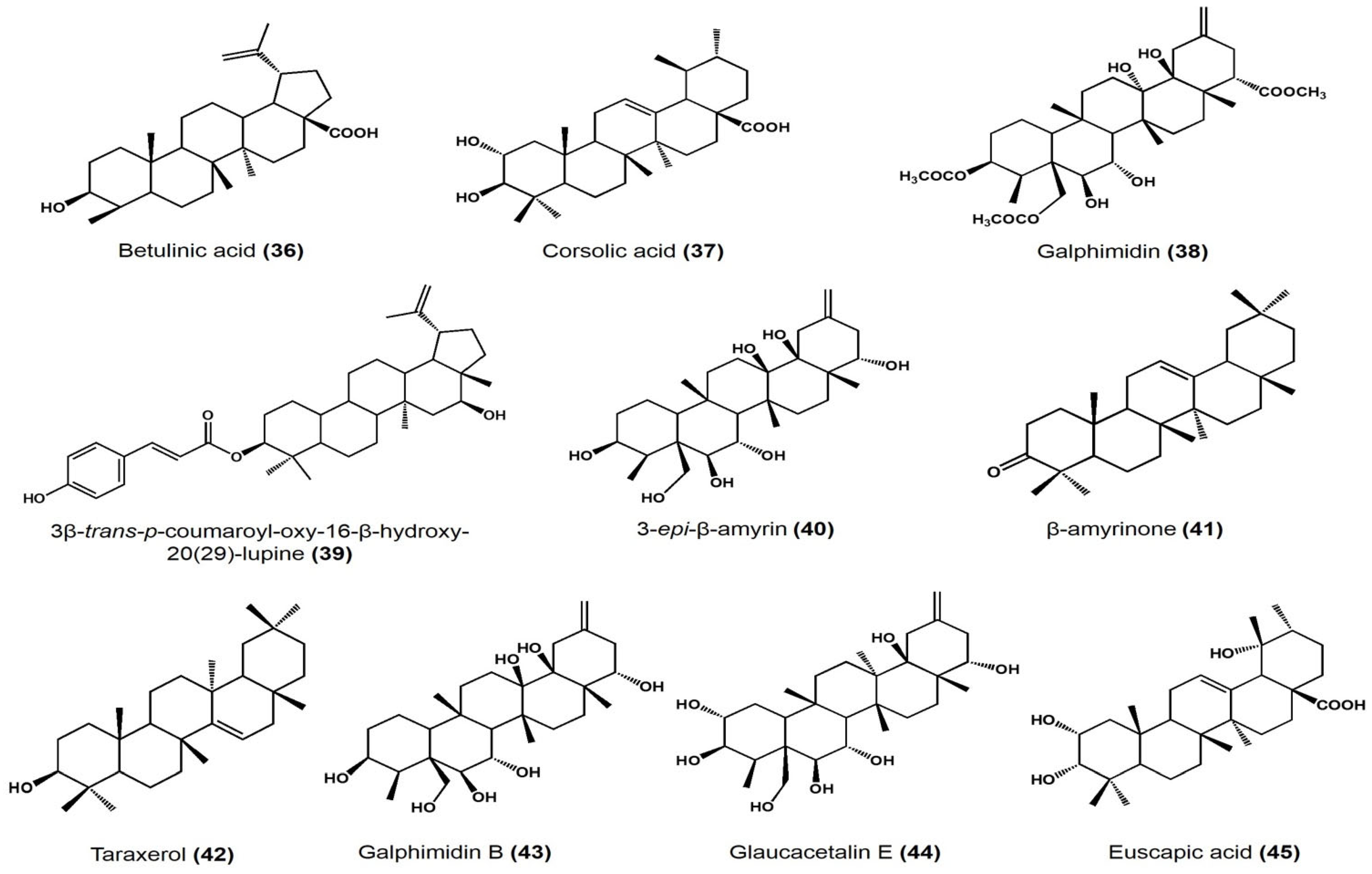
| Plant Species | Identified Compounds | Subgroup | Activities | References |
|---|---|---|---|---|
| Lantana hispida | Oleanolic acid | Oleanane | Antimicrobial activity (MIC) on Mycobacterium tuberculosis: • H37Rv: 25 μg/mL • STR-R, RIF-R, INH-R, and EMB-R: 50 μg/mL | [29] |
| 3-acetoxy-22-(2′-methyl-2Z-butenyloxy)-12-oleanene | Oleanane | Antimicrobial activity (MIC) on M. tuberculosis: • H37Rv, STR-R, and INH-R: 25 μg/mL • RIF-R and EMB-R: 50 μg/mL | ||
| 3-hydroxy-22-(2′-methyl-2Z-butenoyloxy)-12-oleanen-28-oic acid (reduced lantadene A) | Oleanane | Antimicrobial activity (MIC) on M. tuberculosis: • H37Rv, STR-R, RIF-R, INH-R, and EMB-R: 50 μg/mL | ||
| Hippocratea excelsa | 21β-hydroxyolean-12-en-3-one | Oleanane | Antiprotozoal activity (IC50) on Giardia intestinalis: 27.4 μM | [30] |
| 21α-hydroxy-3-oxofriedelane | Friedelane | Antiprotozoal activity (IC50) on G. intestinalis: 19.8 μM | ||
| Pristimerine | Friedelane | Antiprotozoal activity (IC50) on G. intestinalis: 0.11 μM | ||
| Tingenone | Friedelane | Antiprotozoal activity (IC50) on G. intestinalis: 0.74 μM | ||
| Acacia cochliacantha | Lupenone | Lupane | Antimicrobial activity (MIC) on: • Staphylococcus aureus: 2.8 mg/mL • Bacillus subtilis: 1.4 mg/mL • Enterococcus faecium: 5.6 mg/mL • Lactobacillus plantarum: 11.3 mg/mL • Escherichia coli: 2.8 mg/mL • Salmonella typhirium: 22.5 mg/mL • Klebsiella pneumoniae: 22.5 mg/mL | [31] |
| Taraxenone | Taraxerane | Antimicrobial activity (MIC) on: • S. aureus: 0.4 mg/mL • B. subtilis: 1.4 mg/mL • L. plantarum: 1.4 mg/mL • E. coli: 0.2 mg/mL • S. typhirium: 2.8 mg/mL • K. pneumoniae: 1.4 mg/mL • Pseudomonas aeruginosa: 2.8 mg/mL | ||
| Hippocratea excelsa | 11β,21β-dihydroxy-olean-12-ene-3-one | Oleanane | Antiprotozoal activity on Giardia intestinalis: IC50: 184.6 μM | [32] |
| 3α,11α,21β-trihydroxy-olean-12-ene | Oleanane | Antiprotozoal activity on G. intestinalis: IC50: 96.8 μM | ||
| 3α,21β-dihydroxy-11α-methoxy-olean-12-ene | Oleanane | Antiprotozoal activity on G. intestinalis: IC50: 690.7 μM | ||
| 3α,21β-dihydroxy-olean-9(11),12-diene | Oleanane | Antiprotozoal activity on G. intestinalis: IC50:78 μM | ||
| Chamaedora tepejiliote | Ursolic acid | Ursane | Antimicrobial activity (MIC) against M. tuberculosis: • H37Rv, INH-R, RIF-R, EMB-R, MMDO, and MTY147: 25 μg/mL • STR-R: 12.5 μg/mL In vitro intracellular load of M. tubrculosis MDR and H37Rv in macrophages at: • 6.25 μm/mL (14) + 12.5 μm/mL (1): (after 48 h) approximately 101 CFU/mL (both strains) • 0.625 μm/mL (14) + 1.25 μm/mL (1): (after 48 h) approximately 101 CFU/mL (H37Rv) Bacilli load per lung in mice model after 60 days of administration of 1:3 mixture of (1):(14) at 5 mg/kg • 0.1 × 106 bacilli/lung approximately • Control: approximately 0.9 × 106 bacilli/lung | [33] |
| Lantana hispida | Oleanolic acid | Oleanane | Antimicrobial activity (MIC) against M. tuberculosis: • H37Rv, STR-R, MMDO, and MTY147: 50 μg/mL • INH-R, RIF-R and EMB-R: 25 μg/mL In vitro intracellular load of M. tubrculosis MDR and H37Rv in macrophages at: • 6.25 μm/mL: (after 24 and 48 h) approximately 105 CFU/mL. • 0.625 μm/mL: (after 48 h) approximately 105 CFU/mL • Control: approximately 106 CFU/mL Bacilli load per lung in mice model after 60 days of administration of 1:3 mixture of (1):(14) at 5 mg/kg • 0.1 × 106 bacilli/lung approximately• Control: approximately 0.9 × 106 bacilli/lung | |
| Heterotheca inuloides | 3β-friedelinol | Friedelane | Antimicrobial activity (MIC) on Helicobacter pylori: >31.25 μg/mL | [34] |
| α-amyrin and β-amyrin | Ursane | |||
| Lantana camara | Lantanilic acid | Lantadene | Lehismaniacidal activity on L. mexicana: 9.50 ± 0.28 μM | [35] |
| Camaric acid | Lantadene | Lehismaniacidal activity on L. mexicana: 2.52 ± 0.08 μM | ||
| Lantadene B | Lantadene | Lehismaniacidal activity on L. mexicana: 23.45 ± 2.15 μM | ||
| Cisus incisa | α-amyrin-3-O-β-D-gluco pyranoside | Ursane | Antimicrobial activity (MIC) against carbapenems-resistant P. aeruginosa: 100 μg/mL | [36] |
| Cnidosculus spinosus | 3 β-acetoxy-hop-22(29)-ene | Hopane | Inhibitory activity on mouse edema at 0.31 μmol/ear: 57.27 ± 16.99% Inhibition of yeast α-glucosidase at 100 μM: 98.79% | [37] |
| 3β-hydroxy-hop-22(29)-ene [Hopenol B] | Hopane | Inhibitory activity on mouse edema at 0.31 μmol/ear: 27.05 ± 7.38% Inhibition of yeast α-glucosidase at 100 μM: 23.47% Antiparasitic activity on Trypanosoma cruzi at 50 μM: <20% | ||
| 3-oxo-hop-22(29)-ene | Hopane | Inhibitory activity on mouse edema at 0.31 μmol/ear: 17.5 ± 4.11% Inhibition of yeast α-glucosidase at 100 μM:7.39% Antiparasitic activity on Trypanosoma cruzi at 50 μM: <20% | ||
| Agarista mexicana | 12-ursene | Ursane | Hypoglycemic activity on mice models after at 50 mg/kg: • 25.9 ± 6.1% glucose reduction | [38] |
| Bursera copallifera | lupenone | Lupane | Anti-inflammatory activity in mouse edema inhibition at 1 mg/ear: 57.25 ± 1.36%, ID50: 1.052 μmol/ear Reduces NO production in LPS-stimulated macrophages: IC50: 20.08 ± 1.07 μM | [39] |
| Bursera copallifera | α-amyrin | Ursane | Anti-inflammatory activity in mouse edema inhibition at 1 mg/ear: 25 ± 1.81%, ID50: >2.34 μmol/ear Reduces NO production in LPS-stimulated macrophages: IC50: 8.98 ± 1.73 μM | [39] |
| α-amyrin acetate | Ursane | Anti-inflammatory activity in mouse edema inhibition at 1 mg/ear: 69.45 ± 1.8%, ID50: 1.17 μmol/ear Reduces NO production in LPS-stimulated macrophages: IC50: 22.47 ± 1.19 μM | ||
| 3-epilupeol | Lupane | Anti-inflammatory activity in mouse edema inhibition at 1 mg/ear: 66.39 ± 4.38%, ID50: 0.83 μmol/ear Reduces NO production in LPS-stimulated macrophages 15.50 ± 1.14 μM | ||
| 3-epilupeol formiate | Lupane | Anti-inflammatory activity in mouse edema inhibition at 1 mg/ear: 62.16 ± 1.8%, ID50: 0.96 μmol/ear Reduces NO production in LPS-stimulated macrophages 43.31 ± 2.60 μM | ||
| 3-epilupeol acetate | Lupane | Anti-inflammatory activity in mouse edema inhibition at 1 mg/ear: 49.35 ± 3.6%, ID50: >2.13 μmol/ear Reduces NO production in LPS-stimulated macrophages: IC50: 31.13 ± 1.25 μM | ||
| Bursera cuneata | α-amyrin | Ursane | Anti-inflammatory activity in mouse edema inhibition at 0.1 mg/ear: 44.9 ± 1.2% | [40] |
| Moronic acid | Oleanane | Anti-inflammatory activity in mouse edema inhibition at 0.1 mg/ear: 68.1 ± 1.3% Histamine inhibition in a mouse model at 0.1 mg/ear: 73.3 ± 1.1% Macrophages viability reduction at 60 μg/mL: 43% | ||
| Ursolic acid | Ursane | Anti-inflammatory activity in mouse edema inhibition at 0.1 mg/ear: 55.6 ± 2.1% | ||
| Sapium lateriflorum | 3β-palmitoyloxy olean-12-ene | Oleanane | In vitro cytotoxicity: inhibitory effect (%) at 50 μM • PC-3: 1.81 • K562: 6.88 • HCT-15: 10.46 •MCF-7: 3.24 • SKLU-1: 21.95 Anti-inflammatory activity in mouse edema inhibition at 1 μmol/ear: 48.26% | [41] |
| Sapium lateriflorum | 3β-palmitoxlioxi-1β,11α-dihydroxi-olean-12-ene | Oleanane | In vitro cytotoxicity: inhibitory effect (%) at 50 μM • U251: 29.56 • PC-3: 20.72 • K562: 9.86 • HCT-15: 7.24 • MCF-7: 11.53 • SKLU-1: 12.89 Anti-inflammatory activity in mouse edema inhibition at 1 μmol/ear: 68.76% | [41] |
| lupeyl palmitate | Lupane | In vitro cytotoxicity: inhibitory effect (%) at 50 μM • PC-3: 3.05 • K562: 3.46 • HCT-15: 10.24 •MCF-7: 13.43 • SKLU-1: 19.59 Anti-inflammatory activity in mouse edema inhibition at 1 μmol/ear: 22.31% | ||
| 3β-palmitoyloxy-11-oxo- olean-12-ene | Oleanane | In vitro cytotoxicity: inhibitory effect (%) at 50 μM • PC-3: 0.08 • HCT-15: 18.69 •MCF-7: 5.15 • SKLU-1: 20.06 Anti-inflammatory activity in mouse ear edema inhibition at 1 μmol/ear: 31.49%, ID50: 0.60 μmol/ear Anti-inflammatory activity in carrageenan-induced mouse plantar edema at 31.6 mg/kg: 48.2% after 3 h | ||
| Phoradendron reichenbachianum (Viscaceae) | Ursolic acid | Ursane | Vasorelaxant effect on rat aorta: EC50 11.7 μM, Emax 72.59% | [42] |
| Moronic acid | Oleanane | Vasorelaxant effect on rat aorta: EC50 11.7 μM, Emax 92.01% | ||
| Morolic acid | Oleanane | Vasorelaxant effect on rat aorta: EC50 94.19 μM, Emax 73.75% | ||
| Betulinic acid | Lupane | Vasorelaxant effect on rat aorta: EC50 58.46 μM, Emax 79.01% | ||
| Cratageus gracilior | Corsolic acid | Ursane | Vasodilatory effect on rat aorta: EC50 108.9 ± 6.7 μM, Emax 96.4 ± 4.2% | [43] |
| Galphimia glauca | Galphimidin | Nor-seco friedelane | Vasodilatory effect on rat aorta: EC50 145.9 ± 6.7 μM, Emax 99.5 ± 5.3% | |
| Jatropha neupaciflora | 3β-trans-p-coumaroyl-oxy-16-β-hydroxy-20(29)-lupene | Lupane | Vasodilatory effect on rat aorta: 63.2 ± 5.8 μM EC50 and 27.5 ± 1.9% | |
| Sebastiania adenophora | 3-epi-β-amyrin | Ursane | Approximate effect on root growth at 250 μg/mL • Lycopersicon esculentum: −21% • Echinocloa crus-galli: −36% • Amaranthus hypochondriacus: +55% | [44] |
| β-amyrinone | Ursane | Approximate effect on root growth at 250 μg/mL • L. esculentum: −28% • E. crus-galli: −28% • A. hypochondriacus: +39% | ||
| 3-epi-lupeol | Lupane | Approximate effect on root growth at 250 μg/mL • L. esculentum: −32% • E. crus-galli: −9% • A. hypochondriacus: +47% | ||
| Lupenone | Lupane | Approximate effect on root growth at 250 μg/mL • L. esculentum: −36% • E. crus-galli: −5% • A. hypochondriacus: +27% | ||
| Taraxerol | Taraxerane | Approximate effect on root growth at 250 μg/mL • L. esculentum: −41% • E. crus-galli: −77% • A. hypochondriacus: +39% | ||
| Taraxerone | Taraxerane | Approximate effect on root growth at 250 μg/mL • L. esculentum: −49% • E. crus-galli: −44% • A. hypochondriacus: +23% | ||
| Galphimia glauca | Glaucacetalin E | Nor-seco friedelane | Anxiolytic effect on mice at 1, 10, and 30 mg/kg dose | [45] |
| Galphimidin B | Anxiolytic effect on mice at 1, 10, and 30 mg/kg dose | |||
| Galphimidin | Anxiolytic effect on mice at 1, 10, and 30 mg/kg dose |
Publisher’s Note: MDPI stays neutral with regard to jurisdictional claims in published maps and institutional affiliations. |
© 2022 by the authors. Licensee MDPI, Basel, Switzerland. This article is an open access article distributed under the terms and conditions of the Creative Commons Attribution (CC BY) license (https://creativecommons.org/licenses/by/4.0/).
Share and Cite
Alfaro-Almaguer, J.A.; Mejía-Manzano, L.A.; González-Valdez, J. State-of-the-Art and Opportunities for Bioactive Pentacyclic Triterpenes from Native Mexican Plants. Plants 2022, 11, 2184. https://doi.org/10.3390/plants11172184
Alfaro-Almaguer JA, Mejía-Manzano LA, González-Valdez J. State-of-the-Art and Opportunities for Bioactive Pentacyclic Triterpenes from Native Mexican Plants. Plants. 2022; 11(17):2184. https://doi.org/10.3390/plants11172184
Chicago/Turabian StyleAlfaro-Almaguer, Juan Antonio, Luis Alberto Mejía-Manzano, and José González-Valdez. 2022. "State-of-the-Art and Opportunities for Bioactive Pentacyclic Triterpenes from Native Mexican Plants" Plants 11, no. 17: 2184. https://doi.org/10.3390/plants11172184
APA StyleAlfaro-Almaguer, J. A., Mejía-Manzano, L. A., & González-Valdez, J. (2022). State-of-the-Art and Opportunities for Bioactive Pentacyclic Triterpenes from Native Mexican Plants. Plants, 11(17), 2184. https://doi.org/10.3390/plants11172184







